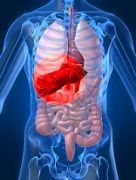Article
Evaluating Risk Factors for Nonalcoholic Steatohepatitis and Nonalcoholic Fatty Liver Disease
Author(s):
There are several known risk factors and "red flags" that should prompt clinicians to suspect nonalcoholic steatohepatitis or nonalcoholic fatty liver disease and conduct appropriate testing.

Clinicians can guide their biopsy decisions for nonalcoholic steatohepatitis (NASH) and nonalcoholic fatty liver disease (NAFLD) by considering a patient’s risk factors, said Rajender Reddy, MD, professor of medicine and director of hepatology, University of Pennsylvania Perelman School of Medicine, Philadelphia.
Reddy provided guidance on NASH during his presentation at the 2014 American Gastroenterological Association Clinical Congress of Gastroenterology and Hepatology in Miami Beach, FL. He gave the presentation for Stephen A. Harrison, MD, professor of medicine, Uniformed Services University of the Health Sciences, San Antonio, who was not present.
Patients who have diabetes and patients of Hispanic background are more likely to have NASH, Reddy said, citing data from Williams et al. published in 2011 in Gastroenterology. The study found that that NASH and NAFLD are more prevalent than previously thought and that patients with NAFLD tended to be older, male, hypertensive, and have a higher body mass index (BMI).
NASH has similar features, Reddy said. NASH red flags include an age of 50 or older, a BMI of 30 or higher, being diabetic, and an aspartate/alanine aminotransferase ratio of 0.8 or greater. Males and Hispanics are more likely to have NASH, which is also more common in people with metabolic syndrome. Clinicians must consider the risk factors heavily because “there’s no lab test or image that can predict NASH with 100% accuracy,” he said.
The goals of conducting a liver biopsy test for NASH are to identify the fibrosis stage, rule out concomitant liver disease, and provide a prognosis to patients. “Non-invasive markers of fibrosis can predict mortality,” Reddy said.
Therapies for NASH and NAFLD include diet, exercise, sleep, coffee, and vitamin D, Dr. Reddy said. He cited a study from Wong et al. published in 2013 in the Journal of Hepatology that found NAFLD resolved in 64% of patients in an intervention group when they underwent lifestyle modifications, including weight loss. “When there was more than 10% weight loss, almost all patients had resolution of NAFLD,” Reddy said.
Other studies have shown the powerful effects of exercise and diet for NASH and NAFLD, including the use of a low-glycemic diet that includes beans, nuts, and seeds. Quality sleep has a positive effect in patients with NASH and NAFLD because it appears to help with weight loss as well.
In at least one study, coffee has been shown to lower the state of fibrosis in NASH, Reddy said. Research also shows that vitamin D concentrations are lower in NASH patients.
Drug therapies for NASH include vitamin E; however, there is insufficient evidence to support the use of vitamin E in NASH patients who are diabetic or who have cirrhosis, Reddy said.





